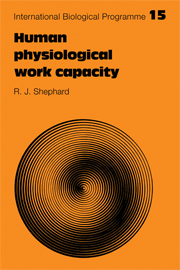Book contents
- Frontmatter
- Contents
- Foreword
- Preface
- 1 Introduction
- 2 Sampling and population studies
- 3 Methods for the measurement of physical fitness, working capacity and activity patterns
- 4 Climate, season and local geography
- 5 Socio-economic status and working capacity
- 6 Working capacity and constitution
- 7 The physical working capacity of the athlete
- 8 The growth of working capacity
- 9 Age and working capacity
- 10 Epilogue
- IBP Human Adaptability section publications
- References
- Index
5 - Socio-economic status and working capacity
Published online by Cambridge University Press: 20 May 2010
- Frontmatter
- Contents
- Foreword
- Preface
- 1 Introduction
- 2 Sampling and population studies
- 3 Methods for the measurement of physical fitness, working capacity and activity patterns
- 4 Climate, season and local geography
- 5 Socio-economic status and working capacity
- 6 Working capacity and constitution
- 7 The physical working capacity of the athlete
- 8 The growth of working capacity
- 9 Age and working capacity
- 10 Epilogue
- IBP Human Adaptability section publications
- References
- Index
Summary
Socio-economic status can have an important influence upon the potential and the realized working capacity of a community through the interaction of such factors as the quantity and quality of available nutrients, family size and habits of child care, the prevalence of disease, and patterns of habitual activity.
Nutrition and physical working capacity
A low total caloric intake and/or a deficiency of first-class protein can retard or permanently stunt growth, thus restricting physical working capacity. Hyponutrition at the time of testing may limit glycogen stores and thus immediate performance. Chronic malnutrition may also sap will-power and the desire to develop potential working capacity.
At the turn of the twentieth century, malnutrition was a significant problem even in countries such as Britain and the United States. Partly for this reason, Dreyer (1920) included a table of weight for height standards in his book The assessment of physical fitness. During World War II, the German authorities discovered that a certain minimum quantity and quality of nutrients were helpful in sustaining the output of slave-labour employed in coal mining.
The working capacity of many indigenous peoples still seems limited by malnutrition, particularly in tropical regions. The activities necessary to subsistence are often completed in the face of severe constitutional handicaps. Thus, MacPherson (1966) describes the highland populations of New Guinea: ‘Although malnutrition has been amply demonstrated in children and protein deficiency is frequent in pregnant and lactating women, and skinfold thickness measurements are low and there is a decline in the weight–height ratio with age and the serum albumin is low, both men and women perform physical feats and show sustained stamina that few of us could match.’
- Type
- Chapter
- Information
- Human Physiological Work Capacity , pp. 81 - 124Publisher: Cambridge University PressPrint publication year: 1978



